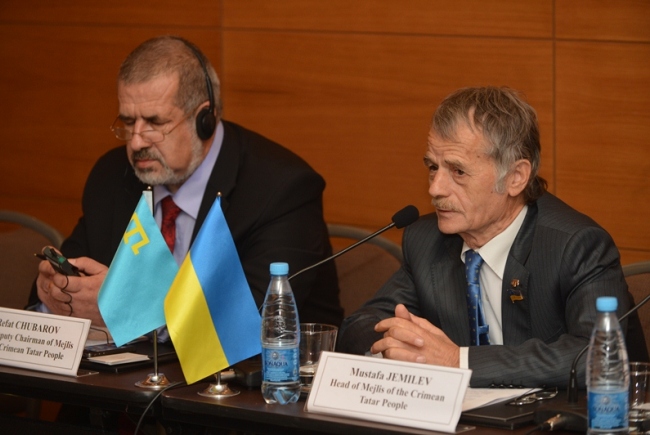
Turkey’s Crimean Tatars Reach Out to Their National Homeland
Publication: Eurasia Daily Monitor Volume: 10 Issue: 120
By:

The leaders of the several-million-strong Crimean Tatar diaspora community in Turkey are increasingly focusing on Crimea. This trend encourages Crimean Tatars living in Crimea to conclude that they have an important political ally in their Turkish compatriots, who are slowing the assimilation trends inside Turkey. This reassertion of a Crimean Tatar identity is being bolstered by many now living in Turkey also focusing on the possibility of the restoration of a Crimean Tatar state. But because of the clever way in which the Crimean Tatars in Turkey have proceeded, their increased attention has in no way reduced the staunchly pro-Crimean Tatar stance of the Turkish government in Ankara.
Last week, Ibrahim Araji, the chairman of the Federation of Crimean Societies of Turkey and head of the Society for Crimean Tatar Culture and Mutual Assistance of Kocaeli, met in Simferopol with Anatoli Mogilev, the chairman of the Council of Ministers of Crimea, to reaffirm “the historical and cultural ties” between Crimea and Turkey, links that are especially strong not only because of their common Turkic heritage but also because of the existence of Crimean Tatars living in both places (ark.gov.ua/blog/tag/ibragim-aradzhi/).
Araji added that Turkey is interested in broadening its links with Crimea in business, education and culture. Mogilev, for his part—and reflecting his rocky relationship with the Crimean Tatars—picked up only on business expansion, saying that he supported such joint efforts as long as they produced good jobs for Crimean residents and did not harm the environment. But clearly the Crimean Tatars of Crimea were on the minds of both men: In addition to the presence of trade and education officials, the meeting was attended by Refat Kenzhaliyev, the head of the Crimean Republic Committee for International Relations and Deported Citizens.
Some might view Araji’s approach as less insufficiently supportive of the Crimean Tatars in Crimea, but in fact, it reflects a clear if implicit division of labor between the Crimean Tatars of Turkey, on the one hand, and the government of the Republic of Turkey, on the other. The Crimean Tatars of Turkey are extremely active and attentive to developments in their ancestral homeland (see their frequently updated umbrella site kirimdernegi.org.tr/). But they have maintained good relations with Ankara, thus allowing the Turkish government to take the lead, as it continues to do, on the status of the Crimean Tatars. Among the many examples of nurturing closer ties were a visit by Turkish Foreign Minister Ahmet Davutoglu to Kyiv last October when he pressed the Ukrainian government on the Crimean Tatars (turkishweekly.net/news/142969/turkish-fm-says-ukraine-talks-focused-on-problems-of-ethnic-tatars-.html) and a visit by 150 Turkish mayors to Simerfopol in May when the Crimean Tatar issue also came up (worldbulletin.net/?aType=haber&ArticleID=109053).
This division reflects the special history of the Crimean Tatars in Turkey. More than 100,000 of their ancestors left Crimea after the peninsula was conquered by Russia’s Catherine the Great, and another 180,000 left in the 1860s following Russia’s occupation of the North Caucasus. Since that time, the community, largely rural and agriculturalist, has been subject to strong assimilationist pressures, especially in the 20th century. Most older Crimean Tatars in Turkey are now bilingual, and many younger ones are fluent only in Turkish (on this history, see Henryk Jankowski’s heavily footnoted 5,000 word article at iccrimea.org/scholarly/jankowski.html).
But despite these pressures, many Crimean Tatars there have not assimilated and continue to refer to themselves as Crimean Tatars or what may be an intermediate identity—Crimean Turks. Moreover, there is evidence that the assimilation of this group has slowed if not stopped since the end of the Soviet Union and the return to the peninsula of many, though not yet all, Crimean Tatar exiles from Central Asia. The successes of the Crimean Tatar movement since that time have inspired great interest and a new sense of pride among the Crimean Tatars of Turkey. Indeed, despite attracting relatively little notice, there may be more Crimean Tatar activism in Turkey today than ever before.
According to one Turkish Crimean Tatar scholar, Filiz Tutku Aydin, this reflects the rise of a new kind of Crimean Tatar nationalism there, one that he calls “diaspora nationalism” because its adherents are integrated into the culture of their host country, in this case, Turkey, but are increasingly attached to developments in their ancestral homeland. Since 1991, he says many Crimean Tatars in Turkey now view themselves and Turkey very differently than did their parents and grandparents. They are helping to power a new national Crimean Tatar consciousness in Turkey even if many are acculturated and do not speak Crimean Tatar well, if at all (iccrimea.org/scholarly/aydin.html).
This nationalism combines attachments to Turkey as well as to Crimea. And because it melds the two, it is both more subtle and potentially more powerful than one that decided to break with the Republic of Turkey to support the Crimean Tatars alone.




